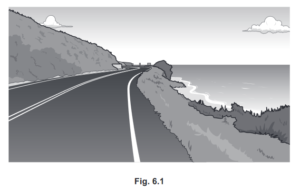Question:
Fig. 6.1 shows a road next to the sea.

(a) On a sunny day, the Sun warms the road.
Describe how energy from the Sun reaches the Earth and warms the road.
Answer/Explanation
Ans: any three from:
radiation
light / infrared / electromagnetic (radiation)
travel through space / vacuum
absorbed by road
(b) The temperature of the road is greater than the temperature of the sea.
The surface of the road is black.
Suggest one reason why the temperature of the road is greater than that of the sea.
Answer/Explanation
Ans: road / black surfaces are good absorbers (of radiation) or sea is a poor absorber (of radiation)
(c) The air above the road is heated by the warm road.
(i) Describe how this affects the molecules of the air.
Answer/Explanation
Ans: they / molecules speed up or gain kinetic energy
they / molecules move further apart
(ii) A cyclist travelling along the road notices that a cool breeze is blowing from the sea to the land.
Explain how convection produces this breeze. You may include a diagram if it helps your answer.
Answer/Explanation
Ans: density (of air above road) decreases or density (of hot air) decreases
air (above land / road) rises or air (that is hot) rises
air (above road) replaced by cool air / air from above sea
Question
Water has a specific heat capacity of 4200 J / (kg °C) and a boiling point of 100 °C.
(a) State what is meant by boiling point.
(b) A mass of 0.30 kg of water at its boiling point is poured into a copper container which is initially at 11 °C. After a few seconds, the temperature of the container and the water are both 95 °C.
(i) Calculate the energy transferred from the water.
energy transferred =
(ii) Calculate the thermal capacity of the copper container.
thermal capacity of the copper container =
(iii) Water from the container evaporates and the temperature of the remaining water decreases slowly.
Explain, in terms of molecules, why evaporation causes the temperature of the remaining water to decrease.
Answer/Explanation
Answer:
(a) temperature at which liquid turns into gas
(b) (i) (E =) mcΔT OR 0.30 × 4200 × (100 – 95)
6300 J
(b) (ii) (C =) E / ΔT OR 6300 / 84
75 J / °C
(b) (ii)molecules do work against attractive force as they evaporate
more energetic molecules more likely to escape
average energy of remaining molecules decreases
